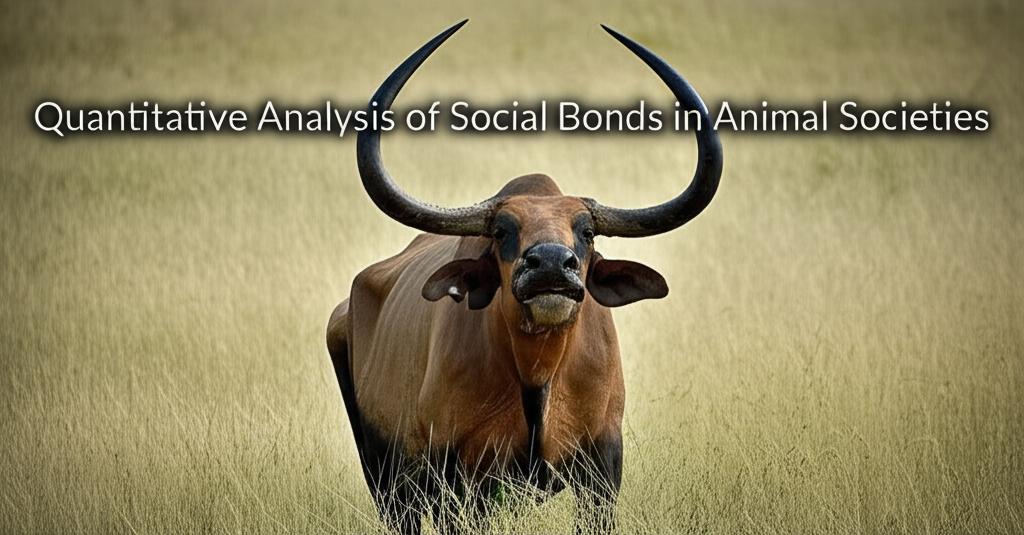Understanding the intricate web of social bonds within animal societies is crucial for comprehending their behavior, ecology, and evolution. Quantitative analysis provides a powerful lens to objectively measure and analyze these complex relationships. Recent advancements in technology and analytical methods have significantly propelled this field forward, allowing for deeper insights into the social lives of diverse species.
At its core, the quantitative analysis of animal social bonds involves defining and measuring interactions and associations between individuals. These can range from direct interactions like grooming, aggression, or food sharing, to indirect associations such as proximity or co-occurrence in specific locations. Social Network Analysis (SNA) has emerged as a cornerstone in this endeavor. SNA treats individuals as nodes in a network and their relationships as edges connecting them. This framework allows researchers to quantify various aspects of social structure, such as an individual's "centrality" (their importance in the network), the presence of subgroups or communities, and the overall cohesiveness of the group.
Recent Technological and Methodological Advancements:The way data is collected and analyzed has been revolutionized in recent years:
- Automated Data Collection: Sensor-based technologies, including GPS trackers, proximity loggers, and automated video recording systems, are increasingly used. These tools allow for continuous and detailed data collection on animal movements, interactions, and associations with minimal human disturbance. This is a significant leap from traditional observational methods, which can be time-consuming and prone to observer bias.
- Machine Learning and Computer Vision: The surge in imaging technology and the development of sophisticated machine learning algorithms, particularly deep learning, have enabled automated tracking and behavior recognition in large groups of animals. This allows for the quantification of subtle and rapid interactions that might be missed by human observers.
- Advanced Statistical Models: Researchers are employing more sophisticated statistical models to analyze social network data. These include stochastic actor-oriented models (SAOMs) to understand the dynamics of relationship formation and dissolution over time, and Network-Based Diffusion Analysis (NBDA) to study how behaviors, information, or even diseases spread through a social network. Bayesian approaches are also gaining traction, offering a robust framework for dealing with uncertainty in data.
- Integration of Multiple Data Types: Modern studies often integrate social network data with other biological information, such as genetic relatedness, physiological stress levels (e.g., hormone analysis), and individual characteristics like age, sex, and personality. This holistic approach provides a more comprehensive understanding of the factors shaping social bonds and their consequences.
Quantitative analysis is shedding light on numerous aspects of animal sociality:
- Evolution of Cooperation and Social Bonds: Game theory models are being combined with empirical data to understand how cooperation and helping behaviors evolve and are maintained through social bonds. Recent research suggests that social bonds develop gradually through a history of mutual aid and shared activities.
- Social Dynamics and Stability: Researchers are investigating the long-term stability of social network structures and how they are affected by demographic changes like births, deaths, and migrations. This includes understanding how individuals, particularly new recruits, integrate into existing social networks.
- Impact on Health, Survival, and Reproduction: A growing body of evidence demonstrates that the strength and nature of social bonds can have significant impacts on an individual's health, ability to cope with stress, survival rates, and reproductive success. For instance, studies on wild baboons have shown that stronger social bonds are linked to increased longevity in both males and females.
- Information Flow and Social Learning: SNA is crucial for understanding how information and novel behaviors spread within a population. The position of an individual within a social network can influence their likelihood of acquiring new information.
- Animal Welfare: In managed animal populations, such as those on farms or in zoos, SNA is being used to assess social structures and their impact on animal welfare. Understanding natural social groupings can inform better management practices that promote positive social interactions and reduce stress.
- Human-Animal Interactions: Quantitative methods are also being applied to understand the nature and strength of bonds between humans and animals, including companion animals and those in managed care.
Despite significant progress, several challenges and exciting future directions remain:
- Defining Social Relationships: Accurately defining what constitutes a meaningful social bond or interaction can still be challenging and may vary significantly between species. Differentiating active social associations from simple spatial proximity requires careful consideration.
- Data Quality and Sampling: The accuracy of network parameters can be sensitive to the amount and quality of data collected. Researchers must carefully consider sampling effort and potential biases in data collection.
- Dynamic and Multi-Layered Networks: Animal social relationships are often dynamic, changing over time and across different contexts. Future research will increasingly focus on analyzing temporal networks and multi-layered networks that capture different types of relationships simultaneously.
- Integrating Proximate and Ultimate Causes: A key goal is to better link the immediate mechanisms underlying social bond formation and maintenance (proximate causes) with their long-term evolutionary consequences (ultimate causes).
- Experimental Approaches: While much research is observational, there is a growing need for experimental manipulations of social networks to directly test hypotheses about the function and consequences of social bonds.
- Cross-Species Comparisons: Developing standardized quantitative measures will facilitate more robust comparisons of social complexity across different species, helping to uncover general principles of social evolution.
In conclusion, the quantitative analysis of social bonds in animal societies is a rapidly evolving and vibrant field. By leveraging technological innovations and sophisticated analytical tools, researchers are gaining unprecedented insights into the complexity, dynamics, and adaptive significance of animal social relationships. This knowledge is not only fundamental to our understanding of the natural world but also has important implications for conservation, animal welfare, and even our understanding of human sociality.

